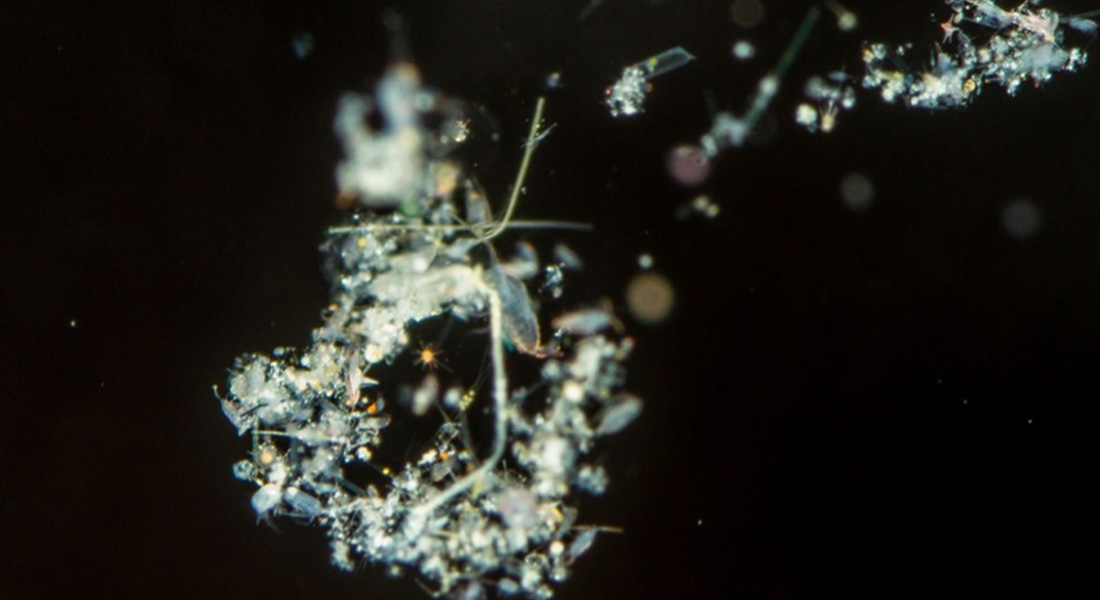Nitrogen fixation on marine particles is important in the global ocean
Nitrogen is essential for all life on Earth. In the global oceans, however, this element is scarce, and nitrogen availability is therefore critical for the growth of marine life. Some bacteria found in marine waters can convert nitrogen gas (N2) to ammonia (known as N2 fixation), and thereby supply the marine food web with nitrogen.

How on Earth?
It has puzzled scientists for years whether and how bacteria, that live from dissolved organic matter in marine waters, can carry out N2 fixation. It was assumed that the high levels of oxygen combined with the low amount of dissolved organic matter in the marine water column would prevent the anaerobic and energy consuming N2 fixation.
Already in the 1980s it was suggested that aggregates, so-called “marine snow particles”, could possibly be suitable sites for N2 fixation, and this was recently confirmed. Still, it has been an open question why the bacteria carrying out this N2fixation can be found worldwide in the ocean. Moreover, the global magnitude and the distribution of the activity have been unknown.
Until now..
In a new study, researchers from the Leibniz Centre for Tropical Marine Research in Germany, Technical University of Denmark, and the University of Copenhagen demonstrate, by use of mechanistic mathematical models, that bacteria attached to marine snow particles can fix N2 over a wide range of temperatures in the global oceans, from the tropics to the poles, and from the surface to the abyss. The study also shows that the activity of these bacteria accounts for about 10% of the overall N2 fixation in the global ocean. The study has just been published in the prestigious Science Advances.
- “It has been almost five years since we started this work when I was a postdoc at the University of Copenhagen explains first-author Subhendu Chakraborty. Then he added “but it was definitely worth the effort, since the results are quite a breakthrough. Indeed our study disputes the long-standing paradigms that oceanic N2 fixation is exclusively restricted to surface waters of the tropical and subtropical oceans and that cyanobacteria are the only important diazotrophs.”
With their mechanistic models the researchers could also show a distinct latitudinal distribution of the bacteria fixing N2on marine snow particles, with highest rates in the oxygen minimum zones found in large regions of the global ocean. Moreover, it was shown that particle-associated bacteria can fix N2 at a much broader temperature range than cyanobacteria.
- “The magnitude of the N2 fixation and the distinct distribution of the particle-associated activity relative to what is known for cyanobacteria are highly interesting”, says Lasse Riemann, Professor at the Department of Biology and co-author of the study. He continues: “By fixing N2 mostly below the surface layers, the bacterial activity associated with particles is expected to have indirect and delayed impact on the oceanic nitrogen cycle compared to that of cyanobacteria. These insights may be particularly important when trying to predict plankton productivity in the future ocean impacted by global warming”.
The researchers hope their study will inspire future work on microbial life on marine particles, due to its seemingly pivotal role in the cycling of many nutrients in the ocean.
Facts
Nitrogen fixation Nitrogen is essential to life since it is required for critical cellular molecules like amino acids, proteins, RNA and DNA. In marine waters accessible nitrogen is scarce. A large amount of nitrogen is found as N2 gas, but this pool is only accessible to the few bacteria that can do so-called nitrogen fixation. Hereby, they convert the N2 gas to ammonia in the cell – a form of nitrogen that can subsequently be exploited by the food web.
Marine snow Marine snow aggregates consist of agglomerates (clusters) of small organic particles, such as live or dead phytoplankton or zooplankton, that descend through the water column. Hereby, organic matter is exported from the sunlit surface waters to the deep ocean and the seafloor.
Funding
Danish Council for Independent Research 6108-00013, Villum Foundation “Ocean Life” and by the European Union under grant agreement no. 965 101083922 (OceanICU)
Research article
Link to Science Advances
Contact
Subhendu Chakraborty
Senior Researcher
Current address: Leibniz Centre for Tropical Marine Research, Germany
E-mail: subhendu.chakraborty@leibniz-zmt.de
Lasse Riemann
Professor
Department of Biology
Mobile: +45 5142 3935
E-mail: lriemann@bio.ku.dk
Helle Blæsild
PR & Communications
Department of Biology
Tel: +45 2875 2076
Mail: helleb@bio.ku.dk
